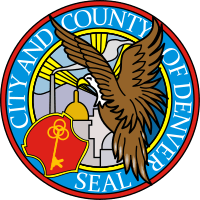Denver Public Schools
 | |
| Public school district | |
| Industry | Education |
| Founded | 1859 (159 years ago) |
| Headquarters | Denver, Colorado |
Key people |
Happy Haynes, School Board President, Tom Boasberg, Superintendent, Susana Cordova, Acting Superintendent |
Number of employees | 13,991 |
| Website | www.dpsk12.org |
The Denver County School District No. 1, more commonly known as the Denver Public Schools (DPS), is the public school system in the City and County of Denver, Colorado, United States.
History
_(14595904590).jpg)
In 1859, Owen J. Goldrick established the Union School, Denver's first school, a private school that served thirteen students.[1] Other private schools opened shortly thereafter to accommodate Denver’s rapidly growing population during the Pike's Peak Gold Rush. In 1861, the new territorial government established Goldrick as the superintendent in Arapahoe County (which then encompassed Denver). Soon after the first two public school districts in Denver were formed: District One on the east side of the city and District Two on the west side. District Two opened the first public school in Denver on December 1, 1862 in a rented log cabin and District One followed suit soon after. On April 2, 1873 the first purpose built school building, the "Arapahoe School", opened.[2]
In 1902, the 20th Amendment to the Constitution of the State of Colorado, known as the Rush Amendment, created the City and County of Denver, separating it from Arapahoe County. In 1903, Denver Public Schools was established. All school districts in Denver County were consolidated into Denver Public Schools, and Aaron Gove became the first-ever DPS Superintendent.
In 2015, the Brookings Institution ranked Denver Public Schools first in school choice among large school districts in the United States.[3][4]
In 2018, Denver Public Schools joined other regional districts in banning its students from attending school-sanctioned trips to the Rocky Flats National Wildlife Refuge citing the history of the area's plutonium contamination and previous designation as a Superfund site.[5][6]
Organization
DPS operates 207 schools, including traditional, magnet, charter and pathways schools, with a current total enrollment of about 92,331 students. Of those, 56% of the school districts enrollment is Hispanic, 23% is Caucasian, 13% is African American, 3% is Asian, 4% is more other, and 1% is American Indian. 140 languages are spoken, and 37% are English language learners. 11% of students have special needs. The poverty rate is 70%.
Under the leadership of Superintendent Tom Boasberg and guided by the tenets of the Denver Plan, DPS has become the fastest-growing urban school district in the nation. The total of DPS graduates has grown from 2,655 in 2006 to 3,608 in 2014. Drop-out rates have dropped from 11.1% in 2006 to 4.5% in 2014.
Student demographics
| Historical student population | ||
|---|---|---|
| Year | Pop. | ±% |
| 2009 | 78,352 | — |
| 2010 | 79,423 | +1.4% |
| 2011 | 81,870 | +3.1% |
| 2012 | 84,424 | +3.1% |
| 2013 | 87,398 | +3.5% |
| 2014 | 90,143 | +3.1% |
| 2015 | 91,429 | +1.4% |
In the 2016-2017 school year, 92,331 students were enrolled in 207 Denver Public Schools consisting of 8 Early Childhood Education or K-12 schools, 92 elementary, 18 ECE-8 or K-8, 34 middle, 12 schools with grades 6-12, and 44 traditional high schools.
71.7 percent (62,977) of public school students qualified for free or reduced price lunch in the 2013-2014 school year.[7]
There are 11,932 employees of DPS; 4,329 of them are teachers.[8]
Race
Although Denver is more than 52 percent non-Hispanic white, minority groups represent double the regular Denver population. The reason for this has been white flight over the past few decades and extremely strong Hispanic school-age growth due to relatively high birth rates. The predominant heritage in the Denver Public School system is Mexican American. Denver has a high Hispanic percentage of roughly 32%, and they are a majority in the public school system.
References
- ↑ "Denver Public Schools: History". dpsk12.org. Denver Public Schools. Retrieved February 18, 2016.
The first school bells in Denver rang out on October 3, 1859 when professor Owen J. Goldrick opened his "Union School". The school, a log cabin, was located on the west side of 12th Street between Larimer and Market Streets. It was a private school with an enrollment of thirteen children and lasted until late in the winter of 1859-60...School resumed classes on May 7, 1860 with Goldrick and an assistant, Miss Miller.
- ↑ Smiley, Jerome C. (1901). History of Denver: With Outlines of the Earlier History of the Rocky Mountain Country. Times-Sun Pub. Co. pp. 735–760. Archived from the original on 2013-01-28.
- ↑ Whitehurst, Grover J. (2015). "Education Choice and Competition Index 2015" (PDF). Brookings.edu. Center on Children and Families, Brookings Institution. Retrieved February 18, 2016.
- ↑ Asmar, Melanie (February 4, 2016). "Denver Public Schools ranks first for school choice among large districts nationwide". co.chalkbeat.com. Chalk Beat Colorado. Retrieved February 18, 2016.
- ↑ "Denver Public Schools Latest District to Ban School Visits to Wildlife Refuge". District Administration. May 1, 2018. Retrieved May 6, 2018.
- ↑ John Aguilar (April 29, 2018). "Nearly 300,000 Colorado Public School Students Now Barred From Making Field Trips to Rocky Flats". The Denver Post. Retrieved May 6, 2018.
- ↑ Denver Children's Affairs, facts sheet Archived 2015-05-26 at the Wayback Machine.
- ↑ "Facts & Figures". Denver Public Schools. Archived from the original on 2015-06-26. Retrieved 2015-06-25.

